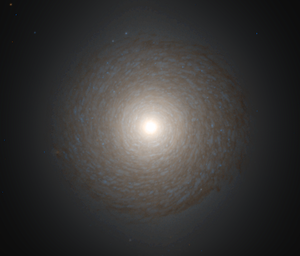NGC 1387
| Galaxy NGC 1387 |
|
|---|---|

|
|
| Photo from the Hubble Space Telescope | |
| AladinLite | |
| Constellation | Chemical furnace |
|
Position equinox : J2000.0 , epoch : J2000.0 |
|
| Right ascension | 03 h 36 m 57 s |
| declination | -35 ° 30 ′ 24 ″ |
| Appearance | |
| Morphological type | SAB (s) 0- |
| Brightness (visual) | 10.8 mag |
| Brightness (B-band) | 11.8 mag |
| Angular expansion | 2.80 × 2.6 |
| Position angle | 119 ° |
| Surface brightness | 13.0 mag / arcmin² |
| Physical data | |
| Affiliation | Fornax cluster |
| Redshift | 0.004343 +/- 0.000040 |
| Radial velocity | 1302 ± 12 km / s |
|
Stroke distance v rad / H 0 |
(53 ± 4) · 10 6 ly (16.2 ± 1.1) Mpc |
| history | |
| discovery | John Herschel |
| Discovery date | December 25, 1835 |
| Catalog names | |
| NGC 1387 • PGC 13344 • ESO 358-G036 • MCG -06-09-07 • IRAS 03350-3540 • 2MASX J03365707-3530240 • SGC 33502-3540.2 • GC 744 • h 2564 • LDCE 249 NED028 • FCC 184 | |
NGC 1387 is an elliptical galaxy of Hubble type I / SB0 in the constellation Fornax the southern sky . It has a brightness of 10.8 mag and an angular dimension of 2.8 '× 2.8'. It is an estimated 53 million light years away from the Milky Way and has a diameter of around 45,000 ly. It is listed as a member of the Fornax Galaxy Cluster under catalog number FCC 184 .
The galaxies NGC 1379 , NGC 1381 , NGC 1389 , NGC 1396 are located in the same area of the sky .
The object was discovered on December 25, 1835 by the British astronomer John Herschel .
Web links
Commons : NGC 1387 - collection of images, videos, and audio files
